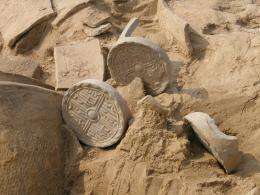Chinese site excavation one of top science stories of the year

A WUSTL professor’s excavation of a "gold mine of archeology" in China has been ranked as one of the top 100 science stories of 2010 by Discover magazine.
T.R. Kidder, PhD, professor and chair of anthropology in Arts & Sciences, has been working with Chinese colleagues to excavate the ancient rural farming village of Sanyangzhuang, which offers a exceptionally well-preserved view of daily life in Western China more than 2,000 years ago.
“It’s an amazing find,” Kidder says of the site, which was discovered in 2003. “We are literally sitting on a gold mine of archeology that is untapped.”
Sanyangzhuang was flooded by silt-heavy water from the Yellow River around 2,000 years ago. The sediment provided a protective layer around the site, leaving it very well preserved.
An abundance of metal tools, including plow shares, has been found, as well as grinding stones and coins. Also found are fossilized impressions of mulberry leaves, which researchers see as a sign of silk cultivation.
“One could make the argument that this is where the Silk Road began,” Kidder says.
More information: For more information on the study, visit news.wustl.edu/news/Pages/20805.aspx
Provided by Washington University in St. Louis













.jpg)






